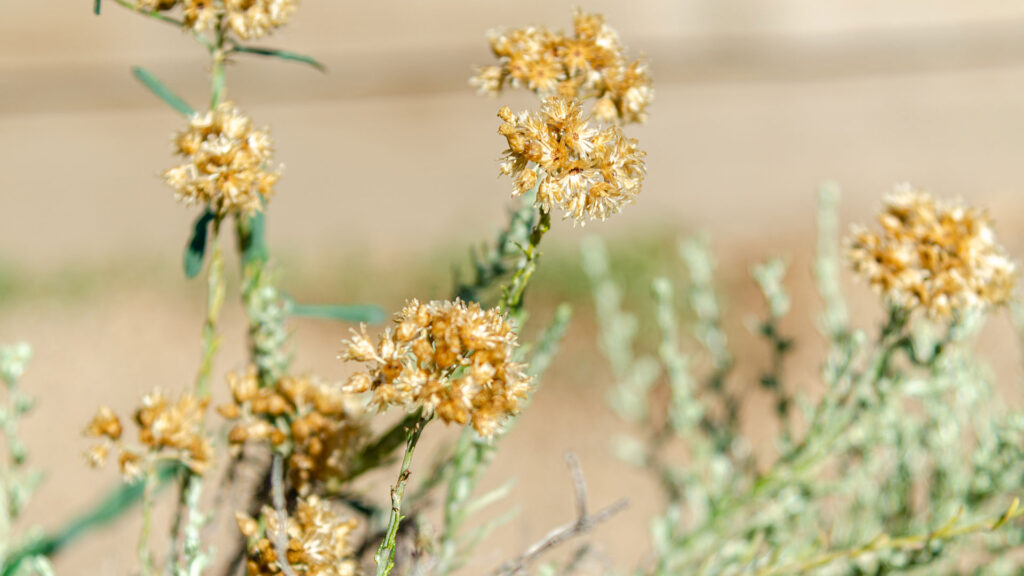Elicriso
Appartiene alla famiglia delle Compositae, il nome Helicrysum deriva dal greco “Helios”, sole e ” Khrysos” oro per i suoi fiori di colore giallo oro simili al sole, è molto diffusa in Sardegna. Detta anche erba di santa maria, è una pianta aromatica perenne molto ramificata fin dalla base, i fiori sono circa 15 per ogni capolino, di colore giallo limone,di forma tubulosa, quelli esterni femminili, quelli centrali ermafroditi.
Cresce sia vicino al mare sia sui pendii e sui monti, molto diffusa sul Limbara fiorisce a giugno/luglio ed è uno dei maggiori “responsabili” del caratteristico “profumo di sardegna”.
Si trova allo stato selvatico ma può essere coltivato, e grazie al suo apparato radicale contribuisce a consolidare i terreni, la parte erbacea si rinnova ogni anno, in estate entra in pausa vegetativa fino alle piogge autunnali con la crescita dei germogli che finisce con l’arrivo del freddo invernale.
Nella nostra Gallura i cespi di elicriso la “buredda” da “burere” (bruciare) venivano usati per bruciare le setole dei maiali macellati per l’aroma che conferiva al lardo e per aromatizzare i cibi. La saggezza contadina aveva individuato le sue proprietà, i cespi di elicriso venivano fatti bruciare in carenza di ossigeno per affumicare e aromatizzare i formaggi, mentre i pescatori col fuoco dell’elicriso affumicavano il polpo.
Dai fiori si ricava un olio essenziale per uso esterno ottimo per le infiammazioni, e altri principi attivi che ne fanno una pianta preziosa in erboristeria e medicina popolare. E’ antiasmatico, anti infiammatorio e ha un’azione benefica nell’ artrite e nelle forme reumatiche acute agisce su psoriasi ed eczemi cura gli eritemi solari e l’infuso viene usato per la pulizia del viso.
Helichrysum
It belongs to the Compositae family, the name Helicrysum derives from the Greek “Helios”, sun and “Khrysos” gold for its golden yellow flowers similar to the sun, it is very common in Sardinia.
Also known as St Mary’s grass, it is a perennial aromatic plant that is very branched right from the base, the flowers are about 15 for each flower head, lemon yellow in colour, tubular in shape, the outer ones female, the central ones hermaphroditic.
It grows both near the sea and on the slopes and mountains, very widespread on the Limbara, it flowers in June/July and is one of the main “responsible” for the characteristic “scent of Sardinia”. It is found in the wild but can be cultivated, and thanks to its root system it helps to consolidate the soil, the herbaceous part is renewed every year, in summer it enters a vegetative pause until the autumn rains with the growth of the shoots which ends with the arrival of winter cold.
In our Gallura the helichrysum tufts the “buredda” from “burere” (to burn) were used to burn the bristles of slaughtered pigs for the aroma they gave to the lard and to flavor foods. The peasant wisdom had identified its properties, the helichrysum tufts were burned in lack of oxygen to smoke and flavor the cheeses, while the fishermen smoked the octopus with the fire of the helichrysum.
From the flowers we obtain an essential oil for external use, excellent for inflammation, and other active ingredients that make it a precious plant in herbal medicine and popular medicine. It is anti-asthmatic, anti-inflammatory and has a beneficial action in arthritis and acute rheumatic forms, it acts on psoriasis and eczema, it cures sunburn and the infusion is used to cleanse the face.
Hélichryse
Il appartient à la famille des Compositae, le nom Helicrysum dérive du grec “Helios”, soleil et “Khrysos” or pour ses fleurs jaune d’or semblable au soleil, il est très commun en Sardaigne.
Aussi appelée herbe de Santa Maria, c’est une plante aromatique vivace très ramifiée dès la base, les fleurs sont environ 15 pour chaque capitule, de couleur jaune citron, de forme tubulaire, les externes femelles, les centrales hermaphrodites . Il pousse presque partout aussi bien près de la mer que sur les pentes et les montagnes, très répandu sur le Mont Limbara, il fleurit en juin/juillet et est l’un des principaux “responsables” du “parfum” caractéristique de la Sardaigne.
On le trouve à l’état sauvage mais il peut être cultivé, et grâce à son système racinaire il contribue beaucoup à consolider le terrain, la partie herbacée se renouvelle chaque année, en été il entre en pause végétative jusqu’aux pluies d’automne avec la croissance du pousses qui se terminent avec l’arrivée du froid hivernal.
Dans notre Gallura les touffes d’hélichryse les “buredda” de “burere” (brûler) servaient à brûler les poils des porcs abattus pour l’arôme qu’ils donnaient au saindoux et pour aromatiser les aliments. La sagesse paysanne avait identifié ses propriétés, les touffes d’hélichryse étaient brûlées par manque d’oxygène pour fumer et aromatiser les fromages, tandis que les pêcheurs fumaient plutôt la pieuvre au feu de l’hélichryse.
Des fleurs, nous obtenons une huile essentielle à usage externe, excellente pour l’inflammation, et d’autres principes actifs qui en font une plante précieuse largement utilisée en phytothérapie et en médecine populaire. Elle est anti-asthmatique, anti-inflammatoire et a une action bénéfique dans l’arthrite et les formes rhumatismales aiguës, elle agit sur le psoriasis et l’eczéma, elle guérit les coups de soleil et l’infusion sert à nettoyer le visage.



